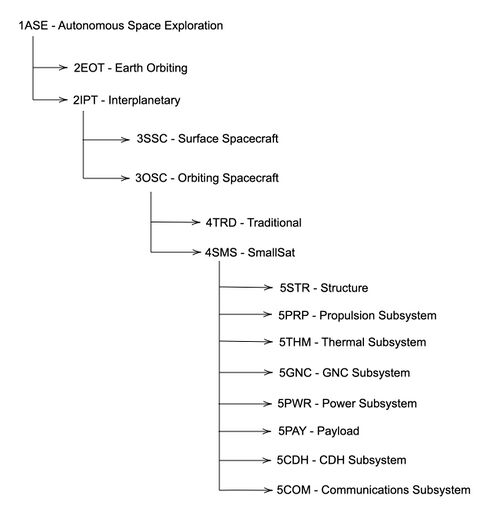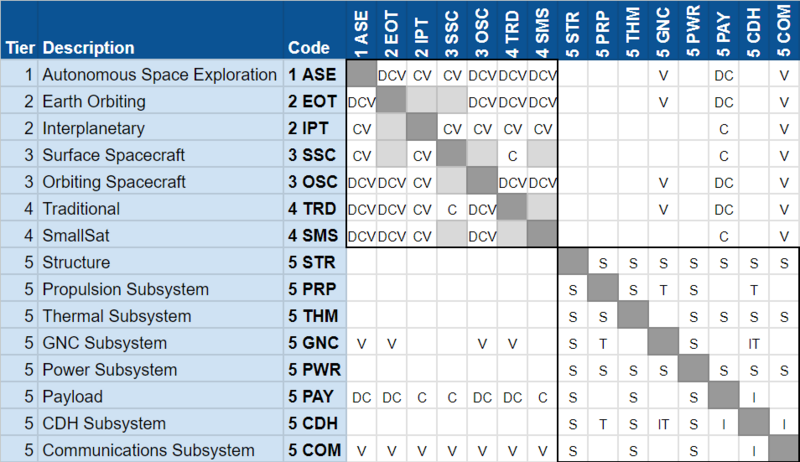Difference between revisions of "Interplanetary SmallSats"
| Line 10: | Line 10: | ||
[[Image:LFLcomponents.gif|frame|center]] | [[Image:LFLcomponents.gif|frame|center]] | ||
==Design Structure Matrix (DSM) Allocation== | ==Design Structure Matrix (DSM) Allocation== | ||
Revision as of 18:34, 8 October 2024
Technology Roadmap Sections and Deliverables
Roadmap Overview
Interplanetary small satellites (SmallSats) are compact, lightweight spacecraft that are designed for science, exploration, and technology demonstration missions beyond Earth's orbit. These satellites, typically ranging in size from 3U-6U and up to 250 kg, leverage advancements in miniaturization, materials, and propulsion technology to conduct missions at a fraction of the cost of a traditional large spacecraft.
Small satellites-- including CubeSats, a specific type of SmallSat-- have traditionally been used in Low Earth Orbit (LEO) since the early 2000's. However, the key differences between interplanetary small satellites and Earth-observing small satellites arise from the need to function at distances much farther than LEO. One key difference is that current designs of interplanetary SmallSats require propulsion subsystems, a feature that is optional for Earth-orbiting SmallSats. Another difference is the method of communication. Whereas LEO satellites can communicate with simple RF ground stations nearly anywhere in the world, the infrastructure required to send and receive signals becomes increasingly complex with distance beyond LEO. Larger ground antennae are required to make up for signal weakening due to distance and free space path loss, which calls for the use of the Deep Space Network. Recent technological advancements, such as the creation of the Iris radio, have allowed these small spacecraft to take on interplanetary missions.
Unlike previous iterations of interplanetary spacecraft (Voyager, Cassini, Mars Reconnaissance Orbiter, etc.), SmallSats can accomplish similar feats to their predecessors for less. Examples of this technology include MarCo (twin 6U CubeSats) and Lunar Flashlight (6U lunar CubeSat), as well as upcoming missions such as Lunar Trailblazer (lunar SmallSat) and EscaPADE (Mars SmallSat twins). These satellites offer new opportunities for low-cost, high-impact science. NASA's SIMPLEx (Small, Innovative Missions for PLanetary Exploration) initiative anticipates this paradigm shift by supporting the formulation of future SmallSat missions. As technology continues to evolve, interplanetary SmallSats are expected to play an increasingly significant role in space exploration.
Design Structure Matrix (DSM) Allocation
Our DSM explores the uses and applications of different technologies within the autonomous space exploration taxonomy. We classified interplanetary small satellites within the orbiting spacecraft section of interplanetary autonomous spacecraft. The subsystems are listed within 4SMS, but could apply to most of the other technologies that stem from 2EOT or 2IPT.
In the top box, the higher level systems are categorized with regard to their applications. These are defense, science, and servicing. Defense refers to spacecraft that can be equipped for surveillance, intelligence, or weaponry. Science refers to spacecraft whose primary purpose is to collect and relay scientific information. Servicing includes spacecraft that support other preexisting missions or Earth-based systems such as Internet or GPS. We further explored what subsystems that are common to most spacecraft might support either of those three applications. Some boxes represent impossible connections; a spacecraft is either Earth-orbiting or interplanetary, it cannot be both. These intersections are highlighted in light gray.
The bottom box classifies the purpose and relationships of the subsystems that may make up an autonomous spacecraft. The three categories are information processing, transportation/navigation, and system support. If two subsystems do not have meaningful interaction, the box is left blank.
Legend:
- D – Defense Application
- C – Science Application
- V – Servicing Application
- I – Information Processing
- T – Transportation/Navigation
- S – System Support
- Grey box – Incompatible Connections
Roadmap Model using OPM
the
Figures of Merit (FOMs)
hello!



